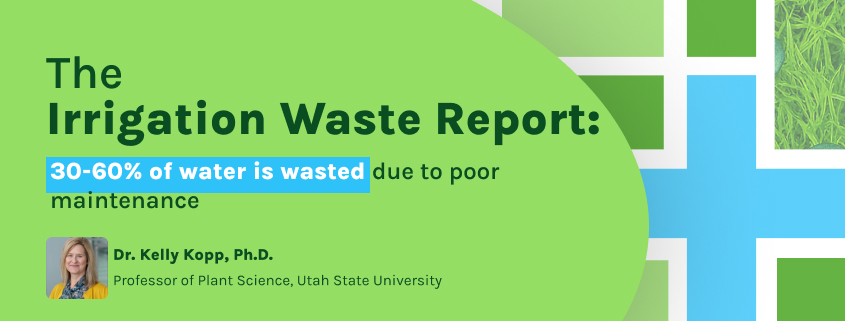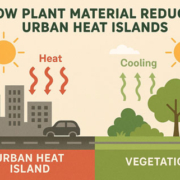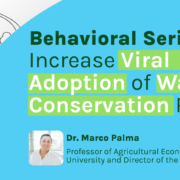Irrigation Waste Report: 30-60% of Water Wasted from Poor Maintenance
Editorial Director: Steve Whitesell
Expert Author: Dr. Kelly Kopp
You don’t need new tech or turf removal to save water—just fix what’s already there.
Research Highlights
- 30–60% of irrigation water is wasted due to common system issues like leaks, broken sprinkler heads, and poor scheduling (Kjelgren et al., 2000; Dukes et al., 2020).
-
Simple maintenance can cut outdoor water use by 20–30% without changing plants or redesigning landscapes (Aveek et al., 2023).
-
A single broken sprinkler head can waste up to 25,000 gallons per year, highlighting the high impact of small repairs (EPA WaterSense™, 2023).
Studies show that 30–60% of irrigation water is wasted due to leaks, misaligned heads, and poor scheduling.
That means most sprinkler systems are silently leaking thousands of gallons—and dollars—each season.
Hidden Waste Is Everywhere—and Fixable
Before considering major upgrades, it’s worth looking closely at what’s already leaking or misfiring. Many issues are common, small, and easily addressed with basic tools.
- Over-irrigation is a leading culprit, harming both water supply and plant health.
- A single broken sprinkler head can waste up to 25,000 gallons/year.
- Common issues:
- Leaks, overspray, broken or tilted heads
- Poorly scheduled or overlapping zones
- Runoff onto pavement, causing landscape and infrastructure damage
These issues highlight how small inefficiencies add up fast—and why proactive system checks are essential.
Maintenance = Simple, Cheap, Effective
Routine maintenance may sound mundane, but it’s a powerful water-saving tool with a quick return. Most tasks require no special equipment and can be completed by property owners or managers.
Routine tasks like adjusting heads and fixing leaks offer 20–30% savings with minimal cost.
Key maintenance actions:
- Adjust spray patterns and fix tilt/misalignment
- Check for leaks, runoff, or misting
- Flush lines seasonally
- Replace worn nozzles or heads (under $20 each)
These small actions can restore distribution uniformity and prevent gallons of water from going to waste each day.
Poor Water Pressure = Big Waste
One often-overlooked culprit of water waste is inconsistent or excessive water pressure. Without regulating pressure, even a well-designed system can lose efficiency.
- Too much pressure → misting, evaporation, runoff
- Too little pressure → poor coverage and unhealthy plants
Solution: Pressure-regulating heads improve efficiency and distribution uniformity
When retrofitted into older systems, pressure regulators help ensure water is delivered where—and how—it’s actually needed.
Water Smarter with Zoning and Scheduling
Design and timing matter. Grouping plants by water needs and scheduling irrigation correctly ensures landscapes receive just enough water—no more, no less.
- Group plants into hydrozones by sun exposure and water needs
- Improve efficiency by 20% or more by tailoring irrigation (St. Hilaire et al., 2008)
- Adjust controllers seasonally to avoid overwatering in cooler months
Together with pressure regulation and maintenance, zoning provides another layer of water-smart strategy.
High ROI, Low Effort
If you’re aiming for fast savings without a hefty upfront cost, this is your answer. Simple fixes are cheap, and the payoff is often immediate.
- Fixes under $20 can save hundreds to thousands of gallons monthly
- Cities like Denver and Las Vegas offer rebates for tune-ups and pressure retrofits
Incentives aside, the ROI from maintenance alone is reason enough to act now.
DIY or Pro: Both Work
Combine DIY Walkthroughs with Pro Audits for Maximum Savings
Maintenance doesn’t require an expert every time—but occasionally bringing one in can uncover hidden inefficiencies.
- DIY monthly walkthroughs: Check for leaks, clogs, and broken components
- Pros offer deeper audits: DU testing, pressure checks, zone mapping
- Find QWEL-certified professionals at QWEL.net
Whether DIY or professional, the goal is the same: efficient, responsive irrigation that saves water and protects your landscape.
Bottom Line: Your Irrigation System Is Your First Line of Defense
Efficient water use isn’t just about new technologies or changing plants—it starts with what’s already underground.
With up to 60% of irrigation water going to waste, ignoring your system is no longer an option.
Whether you manage public landscapes or private properties, maintenance—not replacement—is the fastest, most cost-effective way to save water.
Water conservation starts with what’s underground.
- Walk your property.
- Make a fix.
- Watch your savings grow.
Seasonal Irrigation Maintenance Checklist
By Dr. Kelly Kopp, Ph.D.
Professor of Plant Science, Utah State University | Water Conservation Specialist
Irrigation systems lose up to 60% of water through leaks, poor pressure, and misaligned heads—but regular maintenance can stop the waste.
This expert-backed checklist is for:
- ✅ Homeowners
- 🌿 Landscape managers
- 🏢 Property & HOA teams
Follow these quick seasonal guides to cut water waste, lower bills, and keep landscapes healthy:
- Pre-Season Start-Up: Flush lines, check wiring, align heads
- Monthly Checks: Spot leaks, fix spray patterns, replace broken parts
- Winterization: Drain lines, shut down controllers, and prevent freeze damage
Small fixes = big water savings. Use this checklist year-round to protect your system and the environment.
Fill out the form to download.
References
Aveek, M., D.E. Rosenberg, C. Bastidas, J.S. Horsburgh, B.A. Lane, K. Kopp, P. Mayer and and J. Fazio. 2023. Increasing the Impact of Utah State University’s Extension Water Check Program With 5-Second Metering. Reports. Paper 681. https://digitalcommons.usu.edu/water_rep/681.
Denver Water. 2025. Residential Rebates. Denver Water. Retrieved 4/9/25. https://www.denverwater.org/residential/rebates-and-conservation-tips/residential-rebates?utm_source=chatgpt.com.
Dukes, M.D., J.M.S. Scholberg and J.W. Jones. 2020. Soil moisture sensor irrigation control for maintaining landscape water use efficiency. Applied Engineering in Agriculture 36(3):353-362.
Kjelgren, R., L. Rupp and D. Kilgren. 2000. Water conservation in urban landscapes. HortScience 35(6):1037-1040.
EPA WaterSense. 2023. Outdoor water use in the United States. U.S. Environmental Protection Agency. Retrieved 4/9/25. https://19january2017snapshot.epa.gov/www3/watersense/pubs/outdoor.html.
EPA WaterSense. 2025. Statistics and facts. U.S. Environmental Protection Agency. Retrieved 4/9/25. https://www.epa.gov/watersense/statistics-and-facts?utm_source=chatgpt.com.
Schaible, C., K. Kopp and J. Hoover. 2021. Irrigation system maintenance. Utah State University Extension. Retrieved 4/9/25. https://extension.usu.edu/yardandgarden/research/irrigation-system-maintenance?utm_source=chatgpt.com.
Solomon, K.H., J.A. Kissinger, G.P. Farrens and J.E. Borneman. 2007. Performance and water conservation potential of multi-stream, multi-trajectory rotating sprinklers for landscape irrigation. Applied Engineering in Agriculture 23(2):153-163.
St. Hilaire, R., M.A. Arnold, D.C. Wilkerson, D.A. Devitt, B.H. Hurd, B.J. Lesikar, B. J., V.I. Lohr, C. Martin, G.V. McDonald, R.L. Morris, D.R. Pittenger, D.A. Shaw and D.F. Zoldoske. 2008. Efficient water use in residential urban landscapes. HortScience 43(7):2081-2092.


















